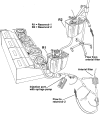Sequential Blood Filtration for Extracorporeal Circulation: Initial Results from a Proof-of-Concept Prototype
- PMID: 26357790
- PMCID: PMC4566833
Sequential Blood Filtration for Extracorporeal Circulation: Initial Results from a Proof-of-Concept Prototype
Abstract
Micropore filters are used during extracorporeal circulation to prevent gaseous and solid particles from entering the patient's systemic circulation. Although these devices improve patient safety, limitations in current designs have prompted the development of a new concept in micropore filtration. A prototype of the new design was made using 40-μm filter screens and compared against four commercially available filters for performance in pressure loss and gross air handling. Pre- and postfilter bubble counts for 5- and 10-mL bolus injections in an ex vivo test circuit were recorded using a Doppler ultrasound bubble counter. Statistical analysis of results for bubble volume reduction between test filters was performed with one-way repeated-measures analysis of variance using Bonferroni post hoc tests. Changes in filter performance with changes in microbubble load were also assessed with dependent t tests using the 5- and 10-mL bolus injections as the paired sample for each filter. Significance was set at p < .05. All filters in the test group were comparable in pressure loss performance, showing a range of 26-33 mmHg at a flow rate of 6 L/min. In gross air-handling studies, the prototype showed improved bubble volume reduction, reaching statistical significance with three of the four commercial filters. All test filters showed decreased performance in bubble volume reduction when the microbubble load was increased. Findings from this research support the underpinning theories of a sequential arterial-line filter design and suggest that improvements in microbubble filtration may be possible using this technique.
Conflict of interest statement
The author has stated he has no material, financial, or other relationship with any healthcare-related business or other entity whose products or services are discussed in this paper.
Figures











References
-
- Griffin S, Pugsley W, Treasure T.. Microembolism during cardiopulmonary bypass: A comparison of bubble oxygenator with arterial line filter and membrane oxygenator alone. Perfusion. 1991;6:99–103.
Publication types
MeSH terms
LinkOut - more resources
Full Text Sources
